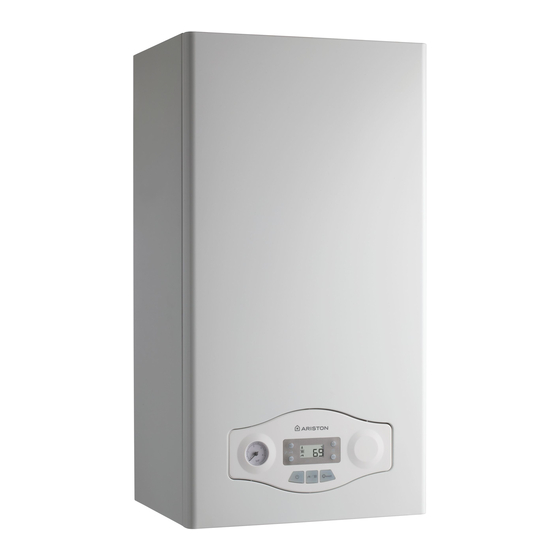Ariston EGIS PREMIUM Series Instructions d'installation et d'entretien - Page 37
Parcourez en ligne ou téléchargez le pdf Instructions d'installation et d'entretien pour {nom_de_la_catégorie} Ariston EGIS PREMIUM Series. Ariston EGIS PREMIUM Series 40 pages. Condensing wall-hunh gas boiler

La manutenzione è essenziale per la sicurezza, il buon funzionamento
e la durata della caldaia. Va eff ettuata in base a quanto previsto dalle
norme vigenti. E' consigliabile eseguire periodicamente l'analisi della
combustione per controllare il rendimento e le emissioni inquinanti
della caldaia, secondo le norme vigenti.
Prima di iniziare le operazioni di manutenzione:
- togliere l'alimentazione elettrica posizionando l'interruttore
bipolare esterno alla caldaia in posizione OFF;
- chiudere il rubinetto del gas e dell'acqua degli impianti termici e
sanitari.
Al termine vanno ripristinate le regolazioni iniziali.
Note Generali
Si raccomanda di eff ettuare sull'apparecchio, almeno una volta
l'anno, i seguenti controlli:
1.
Controllo delle tenute della parte acqua con eventuale
sostituzione delle guarnizioni e ripristino della tenuta.
2.
Controllo delle tenute della parte gas con eventuale sostituzione
delle guarnizioni e ripristino della tenuta.
3.
Controllo visivo dello stato complessivo dell'apparecchio.
4.
A seguito del controllo al punto "3", eventuale smontaggio e
pulizia della camera di combustione.
5.
Controllo e pulizia sifone.
6.
Verifi ca del funzionamento dei sistemi di sicurezza riscaldamento:
- sicurezza temperatura limite.
7.
Verifi ca del funzionamento dei sistemi di sicurezza parte gas:
- sicurezza mancanza gas o fi amma (ionizzazione).
8. Controllo dell'effi cienza della produzione di acqua sanitaria
(verifi ca della portata e della temperatura).
9. Controllo generale del funzionamento dell'apparecchio.
10. Rimozione dell'ossido dall'elettrodo di rilevazione tramite tela
smeriglio.
La presenza di ossido sullo scambiatore non pregiudica le
performance della caldaia. Nel caso si ritenesse opportuno
procedere alla pulizia dello scambiatore, attenersi alle
indicazioni riportate di seguito
Pulizia dello scambiatore primario
Si accede all'interno dello scambiatore
primario
smontando
il
vedi fi gura.
Pulire lo scambiatore con
l'aspirapolvere aiutandosi con un pennello
non metallico, evitando l'uso di liquidi e
prodotti detergenti.
ATTENZIONE!
E' obbligatorio sostituire la guarnizione
(vedi fi gura) ogni volta che si smonta il
bruciatore.
Provvedere anche alla pulizia del condotto
fumi 3 (posto davanti allo scambiatore)
prima di riposizionarlo.
Durante la rimozione del sifone, prevedere
l'utilizzo di un opportuno contenitore per
raccogliere
la
condensa
fuoriuscire dalla caldaia
Pulizia sifone
Si accede al sifone svitando in senso orario il tappo, situato nella
parte inferiore sinistra.
Raccogliere l'acqua di condensa con un contenitore e provvedere al
lavaggio che può essere effettuato con acqua e detergente.
Rimontare il tappo nel suo alloggio.
L'operazione va eseguita alemno una volta l'anno.
Provvedere al riempimento del sifone prima di una nuova
accensione.
Il mancato reintegro dell'acqua nel sifone è pericoloso in quanto
c'è possibilità di uscita di fumi nell'ambiente.
manutenzione
bruciatore
-
che
potrebbe
Maintenance is an essential part of the safe and effi cient operation of
the boiler and ensures its durability. It should be performed according
to the instructions given in current legislation. Perform combustion
analysis regularly in order to check the operating effi ciency of the
boiler and to make sure any polluting substances released are within
the boudaries set by current legislation.
Before beginning maintenance work:
- Disconnect the appliance from the electricity supply by turning
the external bipolar switch to the "OFF" position;
- Close the gas valve and the central heating and domestic hot
water system valves.
After the work has been completed the initial settings will be restored.
General comments
It is recommended that the following inspections be carried out on
the boiler at least once a year:
1.
Check the seals in the water part and, if necessary, replace the
gaskets and restore the seal to perfect working order.
2.
Check the seals in the gas part and, if necessary, replace the
gaskets and restore the seal to perfect working order.
3.
Visually check the overall condition of the boiler.
4.
Following the inspection detailed in point "3", disassemble and
clean the combustion chamber, if necessary.
5.
Check and clean the siphon.
6.
Make sure the following heating safety devices are operating
correctly: - temperature limit safety device.
7.
Make sure that the following gas part safety devices are
operating correctly:
- absence of gas or fl ame safety device (ionisation).
8.
Check the effi ciency of the domestic hot water production
process (test the fl ow rate and temperature).
9.
Perform a general inspection of the boiler operation.
10. Remove oxide from the detection electrode using an emery
cloth.
The presence of the oxide inside the heat exchanger doesn't
prejudice the performances of the boiler. In case it is considered
necessary to proceed with the cleaning of the heat exchanger,
follow the after-written indications.
Cleaning the primary heat exchanger
CLEANING THE FLUE GAS SIDE
The inside of the primary heat exchanger 19
may be accessed by dismantling the burner -
see picture.
Clean the heat exchanger with a vacuum
cleaner with the aid of a non-metallic brush,
by avoiding the use of liquid cleaners and
detergents.
WARNING!
It is mandatory to replace the seal
(g - see picture) every time the burner is
dismantled.
Moreover, clean the fl ue gas duct 3 (located
in front of the heat exchanger) prior to
repositioning it.
During the removal of the siphon, consider
the use of an opportune basin to collect the
condensation water that could fl ow out from the
boiler.
Cleaning the trap
The trap is accessed by emptying the condensate bowl located in the
bottom section. Wash with water and detergent.
Replace the condensate collection bowl in its housing.
NB: In the event of prolonged use of the appliance, the trap must
be fi lled before being used again.
A lack of water in the trap is dangerous and may cause smoke to
be released into the atmosphere.
maintenance
37
